News – Sheridan Media
[[{“value”:”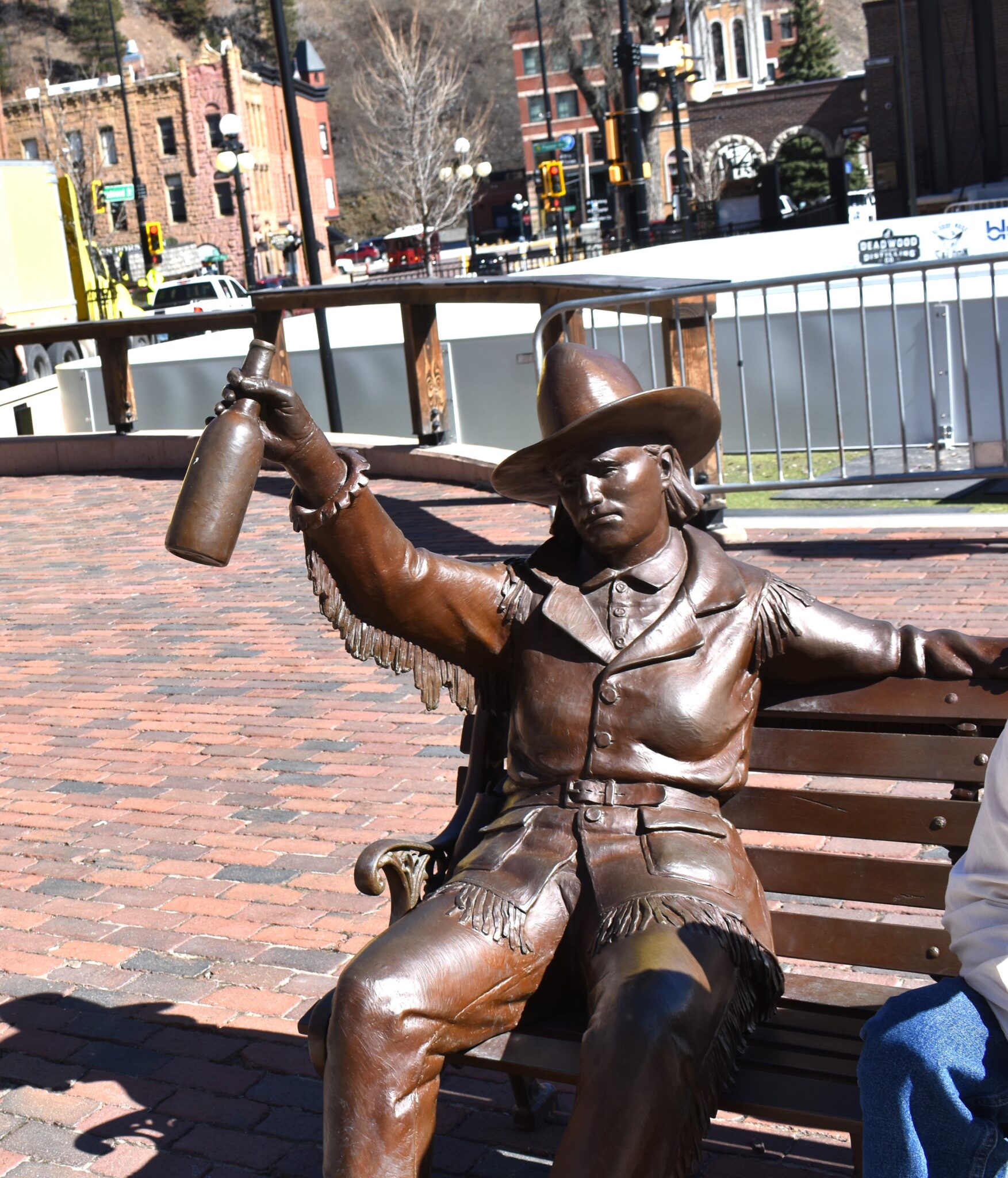
March is Women’s History Month, so in this column we will look at one of the area’s most intriguing woman. In an era and a place where women had few choices for employment, school teaching, domestic help, saloon girls, or wives, Jane stood out as a woman who blazed her own trail in life.
Although best known for dressing like a man, driving a stage, and scouting for the army, she was also a mother, nursed the sick, worked for a time for Dora DuFran, the Black Hills’ leading madam, and had a stint with Buffalo Bill’s Wild West Show.
When Martha Jane was in her teens, her family moved from Missouri to Montana. Orphaned when she was 14, and she had to take care of her five younger siblings.
Although mostly associated with Deadwood, S.D., according to accounts of her written at the time, she covered a lot of ground. From Montana to Fort Bridger, Wyoming, back to Montana with General Custer, and then to Deadwood, S.D. Here is the story of her life as she told it.
The Cheyenne Daily Sun-Leader, September 14, 1898 – Valuable Services Of A Woman in Suppressing Indian Disturbances. And Driving Stage Coaches and Acting as Scout—Story of Calamity Jane. A Globe-Democrat correspondent writes from Crow agency, Mont., as follows: Residing on a ranch near this little city, in close proximity to the historic Custer battlefield, and not far distant from the western home of W. F. Cody, better known as “Buffalo Bill,” there lives a woman with an interesting history, little known even here in Montana. If one were asked what woman in the western states had seen more hardships on the plains, run a ranch successfully, and, in fact, performed all the necessary accomplishments supposed to be done only by the stronger sex whereby the result would be satisfactory financially, through the usual out-door vocations, the invariable answer would be Nannie L. Collins, Montana’s cattle queen.
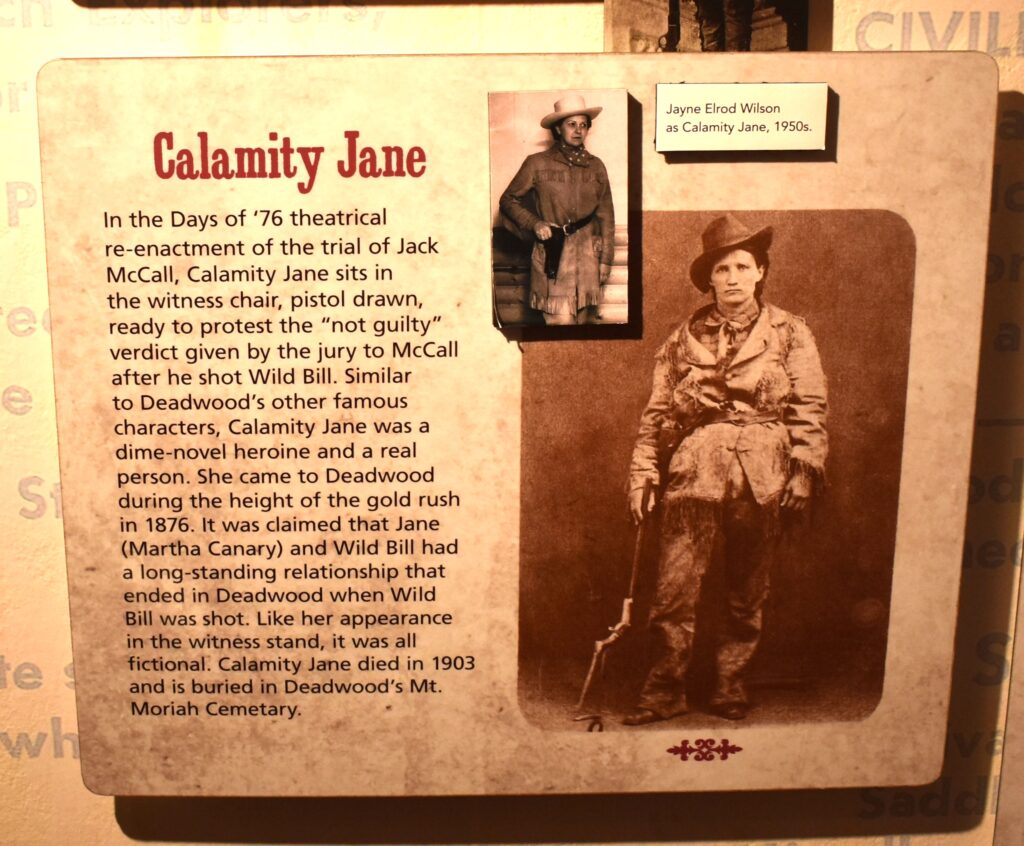
On display at the Days of ’76 Museum in Deadwood. Vannoy Photo.
That answer would be partially true; entirely so as to the latter portion of the question, but as far as concerns “real life on the frontier,” such as a government scout, driving a stage coach, carrying United States mails over practically unbroken trails, shouldering a musket in the service of the United States army under the brave Custer, and, in fact, facing with fortitude every phase of life in those early days when at times even cowardice was bravery, Mrs. Collins, with out detracting in the least from her noteworthy career, must yield the palm to Mrs. Martha Burke, probably better known under the somewhat fastidious title of “Calamity Jane.”
A Globe-Democrat representative had an interview with this exceedingly romantic character, and, feeling that the story of her life may prove interesting to its multitude of readers. It is appended herewith.
Shortly after reaching Montana her mother died, and the father, who in common with 95 per cent of the argonauts, had failed to make a “strike,” determined to return to Missouri. Reaching Salt Lake City, Utah, in 1867, Mr. Cannary also succumbed and the children were left to face the world as best they could.
Employment was found for Martha on a ranch at Fort Bridger, Wyo., and here she improved her time not in “book learning,” for books were not to be had, but at shooting and riding, as the next best accomplishment, and her reputation in that line soon became widespread.
In 1870, learning that Gen. Custer was at Fort Russell, Wyo., she determined to proceed thither, in high hopes that a he might be able to induce him to allow her to accompany him on his campaign against the Apache Indians in Arizona. Up to this time she had always worn the dress of her sex, but hearing that General Custer would be reluctant to permit her to enlist were he aware of her sex, she, after much deliberation, donned the regulation cowboy attire, and was promptly accepted as a scout, being uniformed as a soldier, and, although it was but a short time before her identity was discovered, her ability as a rider was recognized to such an extent that Gen. Custer, with only a slight reprimand for the deception, permitted her to retain her assignment as a scout.
While the campaign was a thrilling one from start to finish, “M. Cannary,” as her name appeared on the muster roll, fully bore her share of the hardships, and met with many adventures in the sometimes dangerous missions given her to be performed, but these she always succeeded in accomplishing in safety. Only at one time did she despair of her life, being entrapped by two Indians, but her ability as a shot served her well, and after wounding one of the Indians, she made her escape, and upon reporting to Gen. Custer, was warmly praised. The outbreak was duly quelled, and upon returning to Fort Lander, Wyo., in 1872, it was reported that the Nursey Pursey Indians in the Musselshell country, were on the warpath, and an expedition under Gens. Custer, Miles, Terry and Crook was ordered there.
It was during this campaign that she received her cognomen “Calamity Jane.” Relating the circumstances thereof, she said: “I was serving under Capt. Egan, and while near Goose creek (the present city of Sheridan, Wyo.), after having been on a three days’ skirmish, during which the company had six men killed and several wounded, we were ambushed about a mile from our destination, Capt. Egan was one of the first to be shot during the engagement, and I happened to be in close proximity to him, and noticed him reeling in his saddle. I was able to reach his side in time to prevent him from falling, and, getting him on my horse in front of me, bore him to camp in safety. After he recovered, one day he laughingly christened me ‘Calamity Jane, the Heroine of the Plains,’ and even to this day she has borne that title among her more intimate friends.”
The Nursey Pursey were subdued in 1873, and the early portion of 1874 was spent in various minor engagement in Montana and Wyoming, when In 1875, under Gen. Crook, she was ordered to the Black Hills of South Dakota, to protect the miners and settlers in that section, as the country was overrun and practically controlled by the Sioux Indiana.
After a nominal campaign in that section, lasting until 1876, they were again ordered north to join Gen. Custer, Miles and Terry on the Big Horn river. During this march Mrs. Burke (Jane did marry a Charley Burke in 1891, and as the article was written in 1898, they could have referred to her by this name) was detailed as the bearer of important dispatches, and although the trip was one of 90 miles, the weather wet and cold, and it necessitated swimming the Platte river at Fort Fetterman, she performed her duty willingly, but at a fearful cost, as she contracted pneumonia and was confined in a hospital for three weeks, and being too ill to return to her company, was granted an indefinite furlough, which in all probability saved her life, for the next year witnessed that fearful massacre in which Gen. Custer and his brave men were so wantonly butchered.
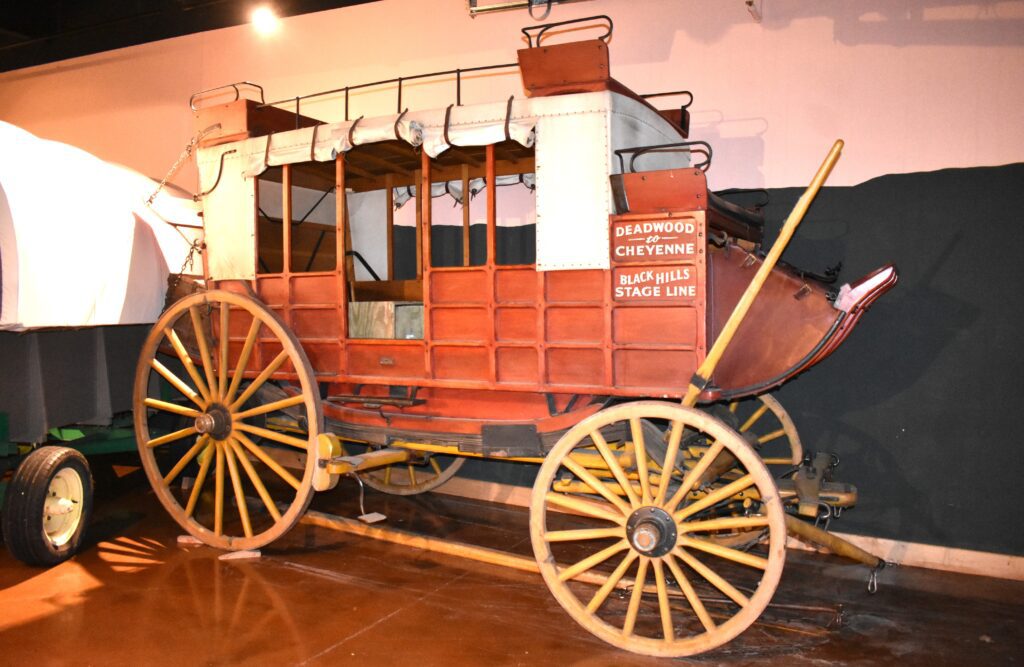
Stagecoach on display at the Days of 76 Museum, Deadwood, S.D. Vannoy photo
“Calamity Jane” next found service in the employ of the government carrying the United States mail between Deadwood and Custer, Mont., and although the route was considered an extremely hazardous one, her reputation as an unerring marksman was such that not once did she have an opportunity to display her skill to either the Sioux or highwayman in behalf of Uncle Sam. While thus engaged she was present in Deadwood at the time Wm. Hlckok (Wild Bill) was assassinated by Jack McCall, a notorious desperado, and was a member of the posse that arrested and confined him in a log cabin, she having the honor of commanding him to surrender, when cornered in a butcher shop, with a meat cleaver as her weapon.
Her love for the army service was such, however, that she again volunteered in the Seventh cavalry, and helped build Fort Meade, S. D., but this sort of work was not to her liking, and in 1878 she was honorably discharged and “took up” a ranch on the Yellowstone river, near Miles City, Mont., which, however, was not a brilliant financial success. In 1884, while visiting in El Paso, Tex., she met Clinton Burke, to whom she was subsequently marrled, and of this marriage a daughter was born. Her husband died in 1895, since which time she has been quietly ensconced on a ranch near here, living a life of contentment so near the scene of her earlier and more exciting escapades.
She was, however, sorely tempted to don her “fighting clothes” last fall, when it was reported that the Indians were on the warpath near Rosebud, yet, she says, her intuition told her it was only a “scare,” and while awaiting developments of a more definite character her insight was proven true, and she did not go.
Mrs. Burke’s voice glows in praise of Gen. Custer, whom she describes as an absolutely fearless, tireless and brave man, and over whose untimely and sudden end she has shed not a few tears. From her front door may be seen the tomb of Gen. Custer, and to this fact may be ascribed the principal reason of her residence here.
Calamity Jane wrote a short book about her exploits, although today’s historians considered it to be highly embellished. She was in Sheridan at one time signing her book.

Wyoming Tribune (Cheyenne), June 4, 1896
Calamity Jane died August 1, of 1903. The Laramie Boomerang, August 8, 1903, had this tribute to her. – Bill Barlow’s Tribute to Calamity Jane – Another old-timer timer has crossed the range-famed in song and story and unique in class and sex – almost the sole remaining personage connected with that stirring scenes and incidents which comprise the passing show which we call life as exemplified in early days when the paradoxical, pistol pulling pioneer was trying to eliminate the frontier.
“Calamity Jane” is dead, and what was left of the wasted form and sin-stained soul has at last found rest in Mount Moriah’s cemetery at Deadwood.
Local history relates that in the early ’70s Jane was one of the army of amorous Aphrodites who filled Black Hills dance houses and saloons—whose life was one dizzy round of illicit pleasure and damning dissipation, after she acquired the prefix of “Calamity” which clung to her during life.
She frequently visited Wyoming, and during the boom days of ’88 was a resident of Douglas. Three weeks ago she boarded a train running into Deadwood on which were a half-hundred members of the National Editorial Association, many of whom were ladies and all of whom were anxious to see this strange type of the half-world of the once wild and wooly west.
Wasted away to little more than a skeleton, hair gray and unkempt, sans teeth and reasonably sober. Jane received her visitors with a dignity and decorum befitting the occasion even though she occasionally thoughtlessly blew a whiff of smoke into their faces from the twofer she was smoking.
“You are a lady—l am only a woman.”was her reply to a good wife and mother who tried to talk to her—a distinction, and a difference as wide as the ocean as the poor soul well knew.
She made the Hills her home during recent years and wanted for nothing-not even her favorite brand of booze. She was the one person in all that country who could ride on railroad trains without being bothered about fare. Food and raiment—and it was little she required of either—were furnished by those of her class, who though bear in-the black brand of the bar-sinister too often set, so called society an example in charity and kindly care of those in distress. She died as she had lived—fearless of the future, and without complaint. At her request, she rests in the same plot and beside a former admirer and pard of her girlhood days—”Wild Bill” Hickock, Murdered in Deadwood in 1876.
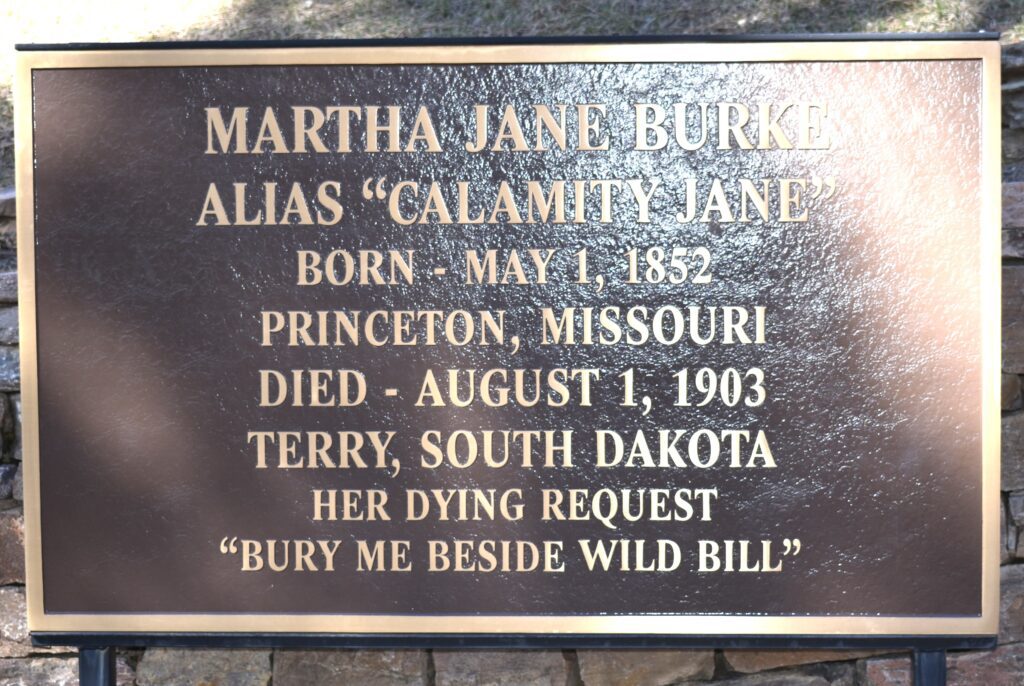
Plaque in Mount Moriah’s cemetery Deadwood.
A precious pair, say you? True — and yet when that day comes, if ever, when life’s book is balanced, who knows what the Deity may set down in their behalf on the credit side of the ledger?
She requested that she be buried near Wild Bill, and no one today is exactly sure what their bond was. Some say they were lovers; some feel it was one-side, more on Calamity’s part than on Hickocks. Some said there was a marriage license, and she once told friends that one of her two (possibly four) daughters was Wild Bill’s child. No one knows for sure.
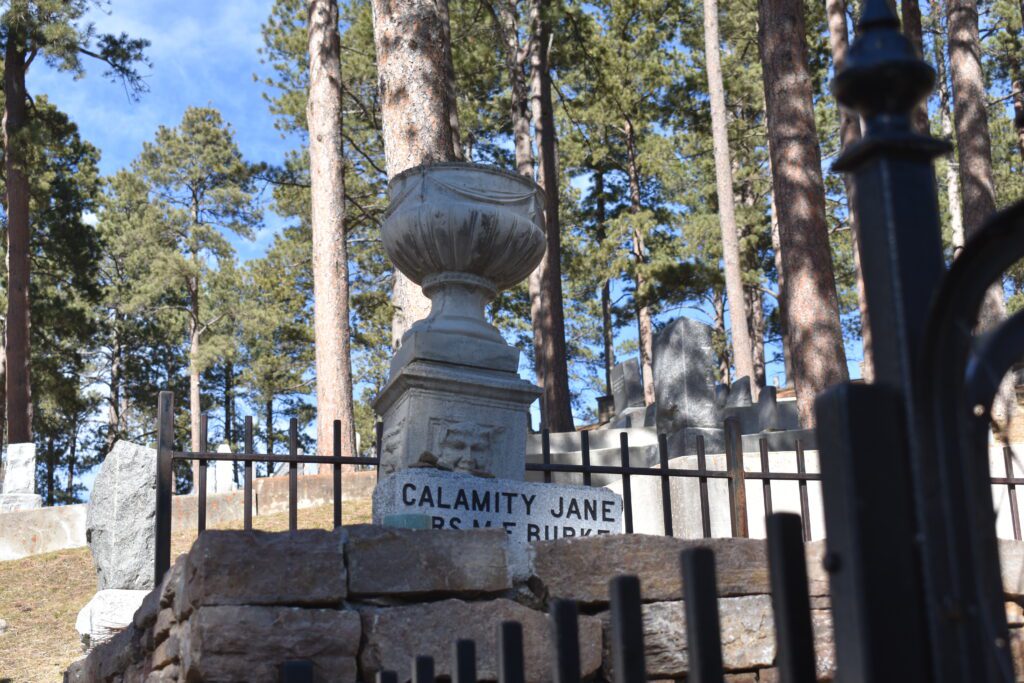
Calamity Jane, a woman who carved her place in Western history.
Feature Image, bronze of Calamity Jane in Deadwood.
“}]]
Last modified: March 30, 2025






